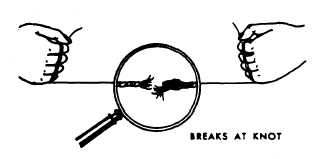3. Sew horsehide and thin leathers one-
eighth inch from the edge in patching, trimming,
etc.
4. Sew the raw edges of 8 to 15 ounce duck
one-half inch from the edge.
5. Fold the material no less than one-half
inch for reinforcement.
6. Sew the folded edges of 8 to 15 ounce
duck one-eighth inch from the folded edge.
7. Make the second and succeeding rows of
stitches one-fourth inch apart. In heavier material,
it is sometimes desirable to separate the rows as
much as three-eighths of an inch.
8. Heavy duck, heavy fabric, or the heavier
leathers may be sewn approximately one-fourth
inch from folded edges for best results, while the
raw edges of such heavy fabrics need at least one-
half inch to three-fourths inch seams for security.
9. Sew light nylon or aircraft fabric one-
sixteenth inch from the folded edge. Raw edges
of these light materials are seldom sewn together,
except as the first step of another seam.
10. When you are sewing a row of stitches and
the thread breaks, start sewing again one-half inch
behind the break, and sew on top of the existing
stitches. This is called backstitching.
The stitches that form the various classes of
seams should be tight, even, and well-set into the
material. An understanding of how the machine
functions to form the stitch and feed the material
provides the basis for you to sew high-quality
seams consistently.
KNOTS
A boy scout’s first achievement is to learn to
tie knots. Knots are necessary to many
activities-camping, boating, mountain climbing,
and parachute rigging. Different knots serve
different purposes. For instance, a hangman
would be out of a job if he forgot how to make
a slip knot. A doctor would have trouble sewing
his patient up after an appendectomy if he didn’t
make a proper surgeon’s knot. Also, you could
never pack a parachute correctly without a
working knowledge of several different types of
knots.
Some specialists have a tendency not to be as
concerned about knots as they are about other
items involved in servicing parachutes. Think of
knots as the treads (and the depth of the treads)
on your automobile tires. Sure, the tire can
perform without treads. But, if the tires are going
to grip the road surface and stop the automobile
in the shortest time and distance possible, they
require good tread depth. Tire treads are designed
to meet many performance requirements. The
same principles apply to knots used in parachute
rigging.
Make sure that all knots and tackings are
changed as often as possible. Their “tread”
deteriorates and becomes loose. Parachutes are
designed to perform under the most unpredictable
situations, at speeds and configurations too great
to imagine. One poorly made knot and tacking
could cause burned suspension lines, excessive
opening shock, or oscillation-all of which could
result in the failure of the parachute. Remember,
no matter how small the task, treat each area of
the parachute with the greatest care and concern.
The type of knot used in assembling
component parts of parachutes depends on the
purpose for which the knot is intended, the
strength required, and the kind of thread, rope,
or cord that is to be used. Remember, knots,
hitches, and turns decrease the tensile strength of
rope, cord, or thread, as shown in figure 10-37.
Some knots are tied for the purpose of breaking
during parachute deployment, and other knots are
tied so as not to break. This is why it is so
important that only the specified knots be used
for a particular job. The following text discusses
the knots you will have to tie as you go about your
job of servicing parachute assemblies.
Overhand knot
The overhand knot is the simplest knot made,
as shown in figure 10-38. It is very important,
Figure 10-37.—Tensile strength decreased by knot.
Figure 10-38.—Overhand knot.
10-28




